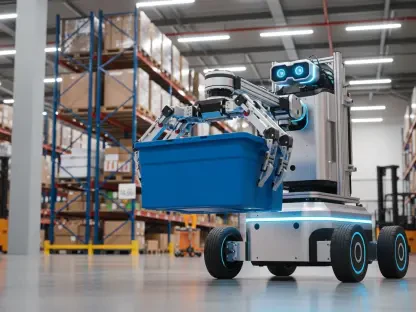Artificial intelligence (AI) is transforming logistics and supply chain management, offering unprecedented opportunities for efficiency and sustainability. Despite the potential, many organizations are still figuring out the best ways to incorporate this evolving technology. Understanding how traditional AI, generative AI, and operations research can work together is crucial for managers aiming to optimize their logistics operations. This integration is not only reshaping the landscape of logistics but is also setting the stage for a future characterized by enhanced performance, agility, and reduced environmental footprints.
The Role of Traditional AI in Logistics
Traditional AI analyzes data to perform specific tasks, making it a foundational tool in logistics. It helps in automating routine processes, such as inventory management and demand forecasting. By analyzing historical data, traditional AI can predict future trends, ensuring that supply chains are better prepared for fluctuations in demand. Additionally, the automation offered by traditional AI reduces manual errors, increasing the accuracy of logistical operations and enabling better resource planning and utilization.
Moreover, traditional AI enhances decision-making by providing real-time insights. For instance, it can monitor the status of shipments and alert managers to potential delays, allowing for proactive measures. This level of visibility is crucial for maintaining the smooth flow of goods and minimizing disruptions. As cargo moves globally, traditional AI’s real-time monitoring abilities ensure that any issues can be quickly identified and rectified, keeping the supply chain resilient and responsive. By leveraging traditional AI, companies can gain a competitive edge through improved efficiency and reduced operational costs.
Generative AI: Creating New Possibilities
Generative AI, which uses large language models to contextualize, summarize, and create new content, is a game-changer in logistics. It can generate detailed reports and summaries, saving time and reducing the burden on human workers. This technology also excels in creating new solutions to complex problems, such as optimizing delivery routes or designing more efficient warehouse layouts. The adaptability of generative AI allows it to tackle various logistical challenges with innovative approaches that were previously unattainable with traditional methods.
One of the most significant advantages of generative AI is its ability to generalize information. Unlike traditional methods that require new algorithms for each variation, generative AI can adapt to different scenarios, such as varying time windows or truck capacities. This flexibility makes it an invaluable tool for logistics managers. Its ability to generalize without the need for reprogramming specific algorithms means that logistics operations can be streamlined and executed with greater precision. As a result, companies can respond more effectively to dynamic market conditions and consumer demands.
Operations Research: Scientific Methods for Decision-Making
Operations research employs scientific methods to analyze systems that require human decision-making, often through linear programming and network models. This approach has long been used in logistics to optimize routes, schedules, and resource allocation. By integrating operations research with AI, companies can achieve even greater efficiencies. The combination of these methodologies allows logistics managers to formulate strategic decisions based on data-driven insights and predictive analytics, ensuring optimal performance across the supply chain.
For example, combining operations research with AI can enhance vehicle routing, a complex problem where determining the most efficient routes can save time and fuel. This integration allows for more accurate and dynamic routing solutions, reducing unnecessary carbon emissions and improving overall efficiency. The synergy between AI and operations research translates to more sophisticated logistical planning, where routes are adjusted in real-time based on current conditions. This not only cuts down on costs but also aligns with sustainability goals by minimizing the environmental impact of logistics activities.
Addressing Fragmented Supply Chains
AI is particularly well-suited to address the challenges of fragmented supply chains. By optimizing connections within these networks, AI can improve outcomes and ensure that goods move smoothly from one point to another. This is especially important in today’s globalized economy, where supply chains often span multiple countries and involve numerous stakeholders. AI’s ability to offer end-to-end visibility and coordination across complex supply networks ensures that disruptions are managed effectively and that the flow of goods remains uninterrupted.
AI can also help manage market volatility by adapting to pricing changes and service disruptions. For instance, machine learning algorithms can analyze market trends and adjust pricing strategies in real-time, ensuring that companies remain competitive and profitable. The predictive capabilities of AI enable logistics providers to anticipate market shifts and adjust their operations accordingly. By harnessing AI, businesses can navigate market uncertainties with greater confidence, maintaining profitability even in fluctuating economic conditions.
Enhancing Safety and Reducing Environmental Impact
Safety is a critical concern in logistics, and AI offers several solutions to improve it. For example, AI can monitor driver behavior and provide real-time feedback to enhance safety on the road. It can also detect and prevent digital fraud, ensuring that transactions are secure and trustworthy. By employing AI-driven safety protocols, logistics companies can significantly reduce the risk of accidents, enhancing the safety of both drivers and transported goods. Additionally, AI can enforce compliance with regulatory standards, further mitigating safety risks in the logistics sector.
In terms of environmental impact, AI can significantly reduce the carbon footprint of trucking and freight. By optimizing routes and reducing empty miles, AI helps minimize fuel consumption and emissions. This not only benefits the environment but also reduces operational costs for logistics companies. AI-driven route optimizations and load balancing result in more efficient transportation cycles, contributing to sustainability initiatives. Reducing the environmental impact of logistics is becoming increasingly important, as consumers and regulators alike prioritize eco-friendly practices.
Practical Applications: Uber Freight’s Innovations
Uber Freight provides a practical example of AI in action. The company uses machine learning to develop algorithmic carrier pricing, ensuring carriers receive guaranteed, upfront pricing. This model evaluates numerous parameters to provide accurate pricing, eliminating the friction of estimating trucking prices. The application of AI in pricing strategies has streamlined the process, fostering trust and reliability between Uber Freight and its carriers. Furthermore, it has allowed Uber Freight to create a more transparent and efficient market for freight services.
Another significant application is in vehicle routing. Uber Freight has used machine learning to design optimal routes, reducing empty miles from approximately 30% to between 10% and 15%. This improvement not only saves time and fuel but also reduces the environmental impact of logistics operations. The company’s success with AI demonstrates the tangible benefits of integrating advanced technologies into logistics, setting a precedent for other companies to follow. By leveraging AI, Uber Freight has shown how logistics can be optimized for both economic and environmental gains.
Overcoming Limitations with Generative AI
Artificial intelligence (AI) is revolutionizing logistics and supply chain management, bringing new levels of efficiency and sustainability. While the potential for AI in these areas is immense, many companies are still exploring the best ways to integrate this rapidly evolving technology. Managers aiming to optimize their logistics operations must understand how to effectively combine traditional AI, generative AI, and operations research. This harmonious integration is not only reshaping the logistics landscape but is also paving the way for a future marked by improved performance, greater agility, and reduced environmental impact. By harnessing the strengths of these technologies, organizations can achieve robust, data-driven decision-making processes that significantly enhance operational efficiency. Additionally, the use of AI can lead to smarter inventory management, better demand forecasting, and more efficient transportation routes. Ultimately, the strategic adoption of AI in logistics is key to staying competitive in an increasingly complex and fast-paced industry.








